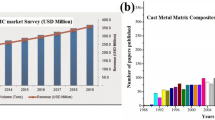Abstract
This paper summarizes attempts to incorporate fly ash into aluminum castings to decrease the energy content, material content, cost, and weight of selected industrial components, while also improving selected properties. It is shown that fly ash can be incorporated into an aluminum-alloy matrixusing stir casting and pressure infiltration techniques. The sand and permanent mold castings, which included differential vovers, intake manifolds brake drums, and outdoor equipment castings including post caps, demonstrate adequate castability of aluminum melts containing up to 10 vol.% fly-ash particles. The potential cost, energy, and pollution savings as a result of incorporation of fly ash in aluminum are discussed in the paper.
Similar content being viewed by others
References
P.K. Rohatgi et al. “Cast Aluminum, Fly Ash Composites for Engineering Applications,” AFS Transactions, 103 (1995), pp 575–579.
R.Q. Guo, P.K. Rohatgi, and S. Ray, “Casting Characteristics of Aluminum-Fly Ash Composites,” Trans. Am. Foundrymen's Soc., 104 (1996), pp. 1097–1101.
G.E. Kiourtsidis, S.M. Skolianos, and G.A. Litsardakis, “Aging Response of Aluminium Alloy 2024/Silicon Carbide Particles (SiCp) Composites,” Materials Science and Engineering A, 382 (1–2) (2004), pp 351–361.
M.S. El-Gallab and M.P. Sklad, “Machining of Aluminum/Silicon Carbide Particulate Metal Matrix Composites. Part IV. Residual Stresses in the Machined Workpiece,” Journal of Materials Processing Technology, 152 (1) (2004), pp. 23–34.
P.K. Rohatgi et al., “Compressive Characteristics of A356/Fly Ash Cenosphere Composites Synthesized by Pressure Infiltration Technique,” Composites Part A, 37 (3) (2006), pp. 430–437.
P.K. Rohatgi, N. Gupta, and Simon Alaraj, “Thermal Expansion of Aluminum-Fly Ash Cenosphere Composites Synthesized by Pressure Infiltration Technique,” Journal of Composite Materials, 40 (2006), pp. 1163–1174.
P.K. Rohatgi et al., “Thermal Expansion of Aluminum/Fly Ash Cenosphere Synthesized by Pressure Infiltration Technique,” Journal of Composite Materials, 40 (13) (2006), pp. 1163–1174.
P.K. Rohatgi et al., “Friction and Abrasion Resistance of Cast Aluminum Alloy-Fly Ash Composites,” Metall. Mater. Trans. A, 28A (1997), pp 245–250.
R.Q. Guo and P.K. Rohatgi, “Chemical Reactions between Aluminum and Fly Ash during Synthesis and Reheating of Al-Fly Ash Composite,” Metall. Mater. Trans. B, 29B (1998), pp. 519–525.
Author information
Authors and Affiliations
Rights and permissions
About this article
Cite this article
Rohatgi, P.K., Weiss, D. & Gupta, N. Applications of fly ash in synthesizing low-cost MMCs for automotive and other applications. JOM 58, 71–76 (2006). https://doi.org/10.1007/s11837-006-0232-4
Issue Date:
DOI: https://doi.org/10.1007/s11837-006-0232-4




